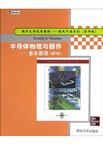半导体物理与器件
2003-12-1
清华大学出版社
Donald A.Neamen
746
无
本书是一本很好的英文教科书和参考书,与目前我国大学本科生的同类教材相比,这本书具有以下特点:
(1)全新的体系结构。目前国内相关专业的教学体系是先学理论物理(包括统计物理、量子力学等)、固体物理,再学半导体物理,最后学半导体器件,一般需要用2至3个学期来学完这些课程。这本书次上述课程的有关内容有机地结合在一起,学生只需具有高等数学和大学物理的基础,用1至2个学期时间就可以系统地学习到半导体物理与器件课程提供的内容。
(2)注重概念方法。从内容的整体编排到具体内容的叙述,都体现了突出物理概念、强调基本分析方法的指导思想。本书还采用了大量的插图,帮助读者理解概念。
(3)可读性强,便于自学。全书思路清晰,说理清楚,易于读者理解和掌握。每章的开头都有引言,告诉读者可以从本章学到什么,应该掌握什么;每章中都有例题和读者自测题;每章的最后还有总结、复习提纲和大量习题(其中一些是计算机模拟的练习题)。
(4)内容丰富,覆盖面广。本书除了介绍半导体物理外,对器件的介绍也相当丰富。除了最基本和常用的BJT和MOSFET器件,还详细介绍了半导体光电器件和功率器件。不仅讲述器件的基本原理,而且介绍了器件的发展。每章后面的参考文献更让读者可以了解到自己所需要的知识细节。
Preface CHAPTER I The Crystal Structure of Solids Preview 1.1 Semiconductor Materials 1.2 Types of Solids 1.3 Space Lattices 1.3.1 Primitive and Unit Cell 1.3.2 Basic Crystal Structures 1.3.3 Crystal Planes and Miller Indices 1.3.4 The Diamond Structure 1.4 Atomic Bonding 1.5 Imperfections and Impurities in Solids 1.5.1 Imperfections in Solids 1.5.2 Impurities in Solids 1.6 Growth of Semiconductor Materials 1.6.1 Growth from a Melt 1.6.2 Epitaxial Growth 1.7 Summary ProblemsCHAPTER 2 Introduction to Quantum Mechanics Preview 2.1 Principles of Quantum Mechanics 2.1.1 Energy Quanta 2.1.2 Wave-Particle Duality 2.1.3 The Uncertainty Principle 2.2 Schrodinger's Wave Equation 2.2.1 The Wave Equation 2.2.2 Physical Meaning of the Wave Function 2.2.3 Boundary Conditions 2.3 Applications of Schrodinger's Wave Equation 2.3.1 Electron in Free Space 2.3.2 The Infinite Potential Well 2.3.3 The Step Potential Function 2.3.4 The Potential Barrier 2.4 Extensions of the Wave Theory to Atoms 2.4.1 The One-Electron Atom 2.4.2 The Periodic Table 2.5 Summary ProblemsCHAPTER 3 Introduction to the Quantum Theory of Solids Preview 3.1 Allowed and Forbidden Energy Bands 3.1.1 Fromation of Energy Bands 3.1.2 The Kronig-Penney Model 3.1.3 The k-Space Diagram 3.2 Electrical Conduction in Solids 3.2.1 The Energy Band and the Bond Model 3.2.2 Drift Current 3.2.3 Electron Effective Mass 3.2.4 Concept of the Hole 3.2.5 Metals,Insulators,and Semiconductors 3.3 Extension to Three Dimensions 3.3.1 The k-Space Diagrams of Si and GaAs 3.3.2 Additional Effective Mass Concepts 3.4 Density of States Function 3.4.1 Mathematical Derivation 3.4.2 Extension to Semiconductors 3.5 Statistical Mechanics 3.5.1 Statistical Laws 3.5.2 The Fermi-Dirac Probability Function 3.5.3 The Distribution Function and the Fermi Energy 3.6 Summary ProblemsCHAPTER 4 The Semiconductor in Equilibrium Preview 4.1 Charge Carriers in Semiconductors 4.1.1 Equilibrium Distribution of Electrons and Holes 4.1.2 The no and po Equations 4.1.3 The Intrinsic Carrier Concentration 4.1.4 The Intrinsic Fermi-Level Position 4.2 Dopant Atoms and Energy Levels 4.2.1 Qualitative Description 4.2.2 Ionization Energy 4.2.3 Group III-V Semiconductors 4.3 The Extrinsic Semiconductor 4.3.1 Equilibrium Distribution of Electrons and Holes 4.3.2 The nopo Product 4.3.3 The Fermi-Dirac Integral 4.3.4 Degenerate and Nondegenerate Semiconducors 4.4 Statistics of Donors and Acceptors 4.4.1 Probability Function 4.4.2 Complete Ionization and Acceptors 4.5 Charge Neutrality 4.5.1 Compenated Semiconductors 4.5.2 Equilibrium Electron and Hole Concentrations 4.6 Position of Fermi Energy Level 4.6.1 Mathematical Derivation 4.6.2 Variation of Ep with Doping Concentration and Temperature 4.6.3 Relevance of the Fermi Energy 4.7 Summary ProblemsCHAPTER 5 Carrier Transport PhenomenaPreview 5.1 Carrier Drift 5.1.1 Drift Current Density 5.1.2 Mobility Effects 5.1.3 Conductivity 5.1.4 Velocity Saturation 5.2 Carrier Diffusion 5.2.1 Diffusion Curent Density 5.2.2 Total Current Density 5.3 Graged Impurity Distribution 5.3.1 Induced Electric Fild 5.3.2 The Einstein Relation 5.4 The Hall Effect 5.5 Summary ProblemsCHAPTER 6 Nonequilibrium Excess Carriers in SemiconductorsPreview 6.1 Carrier Generation and Recombination 6.1.1 The Semiconductor in Equilibrium 6.1.2 Excess Carrier Generation and Recombination 6.2 Characteristics of Excess Carriers 6.2.1 Comtinuity Equations 6.2.2 Time-Dependent Diffusion Equations 6.3 Ambipolar Transport 6.3.1 Derivation of the Ambipolar Transport Equation 6.3.2 Limits of Extrinsic Doping and Low Injection 6.3.3 Applications of the Ambipolar Transport Equation 6.3.4 Dielectric Relaxation Time Constant 6.3.5 Haymes-Shockley Experiment 6.4 Quasi-Fermi Energy Levels 6.5 Excess-Carrier Lifetime 6.5.1 Shockley-Read-Hall Theory of Recombination 6.5.2 Limits of Extrinsic Doping and Low Injection 6.6 Surface Effects 6.6.1 Surface States 6.6.2 Surface Recombination Velocity 6.7 Summary ProblemsCHAPTER 7 The pn JunctionCHAPTER 8 The pn Junction DiodeCHAPTER 9 Metal-Semiconductor and Semiconductor HeterojunctionsCHAPTER 10 The Bipolar TransistorCHAPTER 11 Fundamentals of the Metal-Oxide-Semiconductor Field-Effect TransistorCHAPTER 12 Metal-Oxide-Semiconductor Field-Effect Transistor :Additional ConceptsCHAPTER 13 The Junction Field-Effect TransistorCHAPTER 14 Optical DeviceCHAPTER 15 Semiconductor Power DevicesAPPENDIXIdex

无